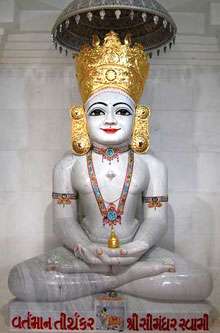Simandhara
Simandhara is a Tīrthaṅkara, an arihant, who is said to be currently living in another world in the Jain cosmological universe.
| Simandhara | |
|---|---|
 Shri Simandhar Swami | |
| Symbol | Bull |
| Color | White |
| Personal information | |
| Parents |
|
| Spouse | Mata Rukmani |
| Part of a series on |
| Jainism |
|---|
 |
|
Jain prayers |
|
Ethics |
|
Major sects |
|
Texts |
|
Festivals
|
|
|
Residence in Jain cosmology
Tirthankara Simandhar Swami resides at Mahavideh Kshetra, another land within the Jain cosmological universe (see Jain cosmology).[1][2][3]
The five lands of the Bharat Kshetra are currently in the 5th Ara (a degraded time-cycle in which Tirthankaras do not take birth).[4][5] The most recent Tirthankara present on Bharat Kshetra (present world) was Vardhamana Mahavira, whom historians estimate lived between 599-527 BCE, the last in a cycle of 24 Tirthankaras.[6][7]
On Mahavideh Kshetra, the 4th Ara (a spiritually elevated time-cycle) exists continuously. There, Tirthankaras perpetually are born.[8][4] There are 5 Mahavideh Kshetras, each being a separate land. At present, there are 4 Tirthankars residing in each Mahavideh Kshetra. Thus there are a total of 20 Tirthankaras residing there, Simandhar Swami being one among them.[2][9]
Biography per Jain tradition
Simandhar Swami is a living Tirthankar, an Arihant, who is said to be currently present on another world in the Jain mythological universe.[10][11] The Arihant Simandhar Swami is believed to be currently 150,000 earth years old (equivalent to 49 years at Mahavideh Kshetra), and has a remaining lifespan of 125,000 earth years.[12][13] He lives in the city of Pundarikgiri, the capital of Pushpakalavati, one of 32 geographical divisions on Mahavideh Kshetra.[2][14][15] Pundarikgiri is ruled by King Shreyans, who is Simandhar Swami’s father. His mother is Queen Satyaki. While pregnant with Simandhar Swami, Queen Satyaki had a sequence of auspicious dreams indicating that she would give birth to a Tirthankara.[16][17] Simandhar Swami was born with three complete aspects of Gnan, Self-knowledge:
- Mati Gnan (see Jain epistemology), knowledge of the 5-sense realm
- Shruta Gnan (see Jain epistemology), knowledge of all forms of communication
- Avadhi Gnan (see Jain epistemology), clairvoyant knowledge[18]
As a young adult, he married Rukamani Devi and then, later in life, took diksha, renunciation from worldly life.[16]
Simandhar Swami’s height is 500 dhanushya, approximately 1,500 feet, which is considered an average height for the people of Mahavideh Kshetra.[2]
Worship
Iconography
Simandhara is usually depicted in a sitting or standing meditative posture with the symbol of a bull beneath him.[19] Every Tīrthankara has a distinguishing emblem that allows worshippers to distinguish similar-looking idols of the Tirthankaras.[20][21][22]
- Simandhara in Digambar Jain temple, Ujjain
 Idol of Simandhar Swami at Trimandir, Vadodara
Idol of Simandhar Swami at Trimandir, Vadodara
Main temples
 Trimandir, Vadodara
Trimandir, Vadodara Adalaj Trimandir Temple
Adalaj Trimandir Temple.jpg)
Notes
- Natubhai Shah 2004.
- University, Jain, Mahavideh Kshetra (PDF), Jain University, archived from the original (PDF) on 16 May 2012
- Darshan, Jain. "Mahavideh Kshetra" (PDF). Jain Darshan.
- Jainism, My. "Kaal Chakra" (PDF). My Jainism. Archived from the original (PDF) on 2 December 2013.
- Jaini 1998, pp. 30–32.
- "Jain Meditation". Archived from the original on 27 April 2012.
- Jaini 1998, pp. 1–41.
- Tirthankaras, Jain. "24 Tirthankaras". Jain Tirthankaras.
- Atmadharma.com. "Adhyatma Pravachanratnatray" (PDF). Atmadharma.com.
- Pravin K Shah, pp. 1–3.
- Umich. "Arihants". Umich.edu.
- http://www.trimandir.org/lord-simandhar-swami/about-simandhar-swami/
- Gnani Purush Dadashri 2005, p. 24.
- Gyan, Jain. "Mahavideh Kshetra". Jain Gyan. Archived from the original on 3 December 2013. Retrieved 27 November 2013.
- Gnani Purush Dadashri 2005, p. 15.
- World, Jain. "Simandhar Swami". Jain World. Retrieved 25 November 2013.
- Dalal, Deepika, Arihant Simandhar Swami (PDF), JAINA, p. 3
- Jaini 1998, p. 3.
- Shah 1987, p. 101.
- Encyclopædia Britannica.
- Krishna 2014, p. 34.
- Zimmer 1953, p. 225.
References
- Bhagwan, Dada (2005), Shree Simandhar Swami, Ahmedabad: Mahavideh Foundation
- Dundas, Paul (2002) [1992], The Jains (Second ed.), London and New York: Routledge, ISBN 0-415-26605-X
- Humphrey and Laidlaw (1994). The archetypal actions of ritual: a theory of ritual illustrated by the Jain rite of worship. Indiana University: Clarendon Press. ISBN 0198279477.
- Jaini, Padmanabh S. (1998) [1979], The Jaina Path of Purification, Delhi: Motilal Banarsidass, ISBN 81-208-1578-5
- King; Brockington (2005), Intimate Other, The Love Divine in Indic Religions, Orient Blackswan, ISBN 978-81-250-2801-7
- Shah, Natubhai (2004) [First published in 1998], Jainism: The World of Conquerors, I, Motilal Banarsidass, ISBN 81-208-1938-1
- Shah, Pravin K, Jain Philosophy and Practice 1 (PDF), JAINA Education Committee, ISBN 8185568014
- Dadashri, Gnani Purush, The Current Living Tirthankara Shree Simandhar Swami (PDF), Dada Bhagwan Aradhana Trust
- Zimmer, Heinrich (1953) [April 1952], Campbell, Joseph (ed.), Philosophies Of India, London, E.C. 4: Routledge & Kegan Paul Ltd, ISBN 978-81-208-0739-6CS1 maint: location (link)
- Britannica Tirthankar Definition, Encyclopædia Britannica
- Krishna, Nanditha (2014), Sacred Animals of India, Penguin UK, ISBN 9788184751826
- Shah, Umakant Premanand (1987), Jaina-rūpa-maṇḍana: (Jaina iconography), 1, Abhinav Publications, ISBN 9788170172086